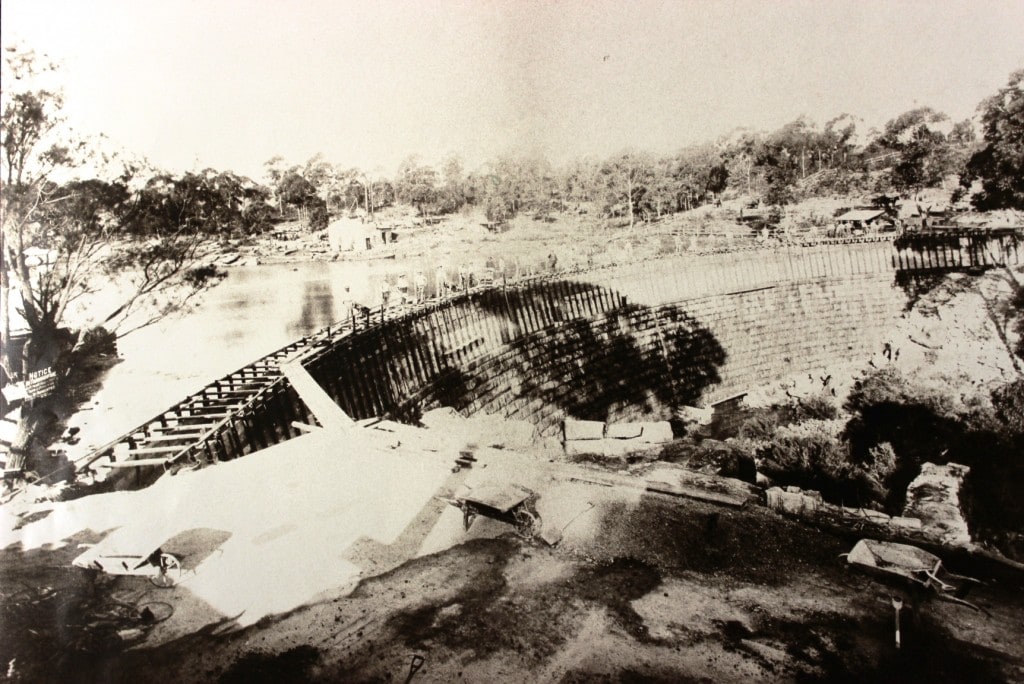
After an absence of 73 years life savers have returned to Lake Parramatta following the reopening of the lake for public swimming and water recreation activities.
The 75 hectare reserve and surrounds were originally home to the Burramattagal clan of the Darug Aboriginal people. Their former occupation is evident through the presence of hand-stencils, shelters, campsites, and tree scars. The existence of the lake is due to early Parramatta’s need for fresh water. Drinking water was originally sourced from the Parramatta River weir at Marsden Street.
By the 1840’s the town’s drinking water became a health risk because of pollution from tanneries, wool washing operations, the Female Factory, gaol and hospital. The District Council petitioned the Legislative Council in 1848 and 1849 to provide funds to build a new reservoir.(1) Funding was secured and two sites were put forward, a dam at Toongabbie Creek or a dam at Hunt’s Creek. Hunt’s Creek was the preferred site and in 1851 John Stewart’s tender for the construction of the dam was accepted. Work commenced in August 1851 however differences between the contractor and the committee managing the work saw Stewart, and two subsequent builders give up their contracts. A new supervising committee was formed which accepted a fresh tender from Captain Percy Simpson who had designed an unusual circular dam. The foundation stone for the dam was laid in June 1855 and construction completed the following year. (2)

Photograph of engineering works to increase the capacity of Parramatta Dam in 1898. Image Parramatta Heritage Centre
It was largely through the efforts of James Pye, an orchardist, publican, and Parramatta Mayor, that the dam was actually completed. Although it took longer than expected, it was also due to Pye’s commitment that fresh water from the dam was eventually piped directly to Parramatta in 1881.
In 1917 the Waterboard took control of the lake before handing it back to Council in 1927. The construction of the dam enhanced an already idyllic spot with the higher waters lapping the rocks of this rugged and wooded location providing Parramatta with a valuable recreational reserve. With such a unique and beautiful resource available close to a growing population centre Parramatta Council undertook a program to initiate improvements to the park for the benefit of visitors and swimmers. Hunt’s Creek Reserve, as it was know then, was officially named Lake Parramatta and opened for recreational purposes in 1930.
Lake Parramatta Life Saving Club, perhaps an offshoot of the Parramatta and District Life Saving Club, was responsible for the safety of swimmers at the lake. At that time it may have been the largest inland freshwater life saving club in Australia. The club held regularly swimming carnivals, life saving exhibitions, and fund raising events, eventually erecting a club house in 1937. As placid as the lake was, and still is, the life savers were kept busy. In the 1935-36 swimming season alone there were over 132 casualties of which 23 people were rescued by club members.(3) Despite the lake’s popularity the Council was forced to close it to recreational swimming in December 1942. The club as a result ceased to operate.
Now it is the Australian Life Guard Service, the largest provider of professional beach lifeguards, which has been contracted by Council to provide services at the lake on weekends. The opening of the lake is the first part of a ten year plan to revitalise the district’s river and creeks for public use and swimming.
![]()
Peter Arfanis, Archivist, Parramatta Council, Parramatta Heritage Centre, 2015
References
(1) Kass, Terry, Liston Carol, McClymont, John. Parramatta A Past Revealed
(2) Jervis, James. Lake Parramatta. 1958. Parramatta Council File no. 48/16 (a)
(3) Lake Parramatta Lifesavers’ Fine Record. (1936, July 23). The Cumberland Argus and Fruitgrowers Advocate p. 4. http://nla.gov.au/nla.news-article104688016




